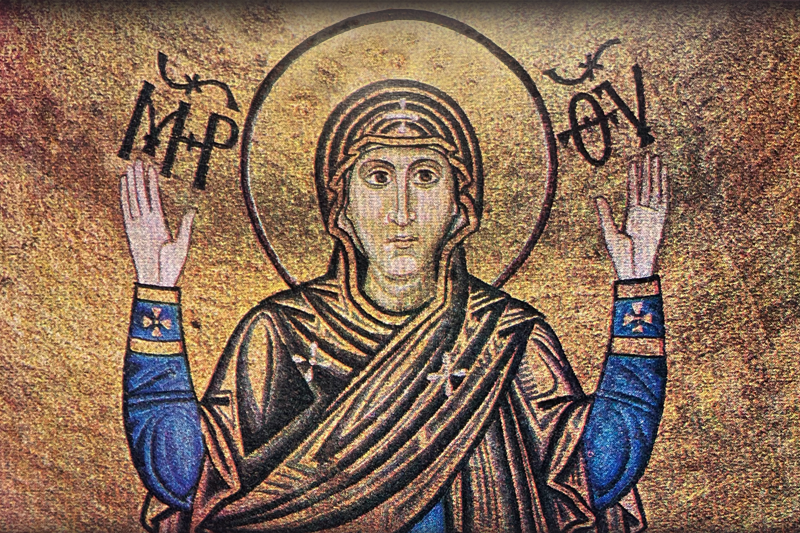Blogs

Freedom, Protection, Resistance
By Melanie Fields
Marian Library librarian/archivist Kayla Harris explains why images of the Blessed Mother are showing up in news dispatches from Ukraine.
Icons of Mary carry special meaning to many Ukrainian Christians. The “Oranta,” or the “Great Panagia,” which depicts the Blessed Mother with her arms extended upward, is popularly known as the “Immovable Wall” or the “Indestructible Wall.” A mosaic of the Oranta in St. Sophia Cathedral, built in Kyiv in the 11th century, is one of the most famous spiritual landmarks in Kyiv.
The creator of this mosaic calculated precisely the strength and the angle of the sun’s rays at noon, the moment many Catholics pray the Angelus. Illuminated by the sun’s rays, Mary’s blue and violet dress, embroidered with gold, shines in radiant splendor. The dress’s composition and decoration make the icon seem even larger, imbued with mysticism, majesty and holiness. On the arch of the cathedral’s apse, a quotation from Psalm 46 reads in Greek, “God is in her midst; she shall not be disturbed; God will help her at the break of Dawn” (Psalm 46:6).
Pope John Paul II on Kyiv’s Cathedral
St. Sophia Cathedral has survived centuries of war and is now a museum. Many Ukrainians in Kyiv believe that as long as the icon stands, Kyiv and Ukraine will continue to stand as well.
“Kyiv is a holy city because it is a Marian city ‘par excellence,’” said Pope John Paul II on Nov. 22, 1987. “In it, the praying Madonna is invoked as protectress of the city. Here for a thousand years, the Holy Oranta is raising her praying hands from the wall of St. Sophia cathedral in her intercessory prayers before God. It is called the ‘indestructible wall — Nerushyma Stina.’”
The cathedral is one of seven UNESCO World Heritage Sites in Ukraine, and religious and cultural authorities have voiced concern that it could be at risk during the present invasion.
Mary: Woman of Freedom
In 1988, Ukrainians across the world celebrated their country’s millennium of Marian devotion. At the time, Ukraine was still behind the Iron Curtain, but it declared its independence in 1991, the same year the Soviet Union collapsed. During this era, countries beyond Ukraine were also seeking their own independence. As such, Marian icons created during this era — including two in the Marian Library by Slovakian artist Mikuláš Klimčák — showcase the importance of freedom. In one, Mary stands above the entire world while angels hold a banner reading “Freedom”; the other shows Mary and Jesus with hands stretched out in blessing over the Earth. These images serve as a reminder that Mary offers comfort to all those who are oppressed and that the struggle for independence and autonomy have remained universal themes in human history.
The images below show variations and interpretations of the symbolism found in Orante and Pokrova icons as well as the Klimčák icons created in 1993. In all of them, Mary holds up her hands in blessing and protection over her people and the Earth.
See more from the Marian Library
- View more blog posts and collection items related to Ukraine.
- View images from the Ukrainian Marian collection on Pinterest.





